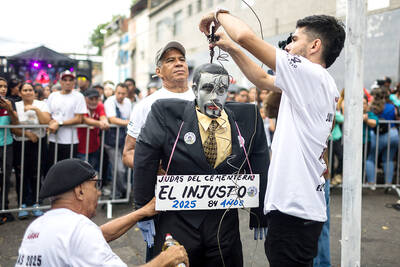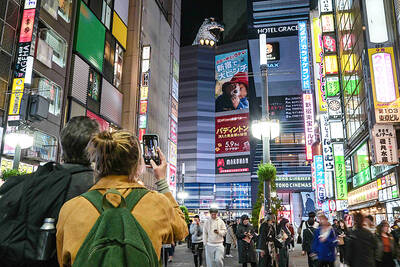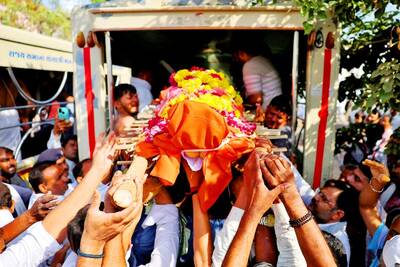A drone dispersed clouds of disinfectant in the sky above Indonesia’s second-largest city, Surabaya, on Tuesday, a response to the COVID-19 pandemic which is catching on around the world, despite warnings from health experts.
Mass disinfections, often by workers in protective clothing resembling characters from the movie Ghostbusters, have become a common sight worldwide.
However, the visually impressive measures taken to contain the coronavirus have been criticized by disease specialists as a health hazard, as well as a waste of time.
“It’s a ridiculous image seen in many countries,” said Dale Fisher, an infectious diseases expert in Singapore who chairs the Global Outbreak Alert and Response Network coordinated by the WHO. “I don’t believe it adds anything to the response and could be toxic on people. The virus does not survive for long in the environment and people do not generally touch the ground.”
Spokesman for Surabaya’s major Febriadhitya Prajatara said that the use of drones for disinfection was necessary in areas with confirmed cases, because the coronavirus “can be anywhere.”
He compared the benzalkonium chloride disinfectant, which can cause skin irritations in high concentrations, to “soap” and said it would help “weaken the virus so it won’t enter our body.”
Coronavirus is a contagious respiratory disease that spreads through droplets from the nose or mouth via coughing or sneezing. People can also become infected by contacting something contaminated before touching their own nose, mouth or eyes.
Paul Tambyah of the Asia Pacific Society of Clinical Microbiology and Infection said handwashing and targeted cleaning of surfaces such as elevator buttons offered better protection than mass disinfection.
“It [spraying] is probably a cheap and visible way of doing it, but careful attention to personal and environmental hygiene is probably more effective,” Tambyah said.
Indian health workers on Monday caused outrage when they used hose pipes to douse migrant workers in northern Utter Pradesh state, amid fears the movement of people from cities to the countryside risked spreading the coronavirus.
In Malaysia, under nationwide lockdown, authorities have gone on a disinfection spree in areas with high case numbers to reduce the risk of further transmission, but images of plumes of disinfectant spray fired from trucks into the air or from spray guns on to roads have riled health experts.
“Disinfecting roads is clearly not going to be impactful,” said Christopher Lee, a former Malasian deputy director-general of health and an infectious disease specialist. “Waste of resources and man hours.”
Malaysian Director-General of Health Noor Hisham Abdullah on Tuesday said that the government would be issuing guidelines to local authorities to make sure disinfections are carried out properly.
In Indonesia, telephone box-shaped disinfection chambers are being set up across the capital, Jakarta, offering passersby a quick blast to rid their clothes and skin of potential germs.
“I think it’s good... I feel sanitized after touching a lot of things from the bus... I feel well-protected,” Jakarta resident Fany Anisa said after exiting one of the chambers next to a bus stop.
The private initiative being rolled out with the support of local authorities has been criticized by one expert, who is advising the government’s coronavirus task force.
“It is not good for skin, mouth and eyes, it will cause irritation,” said Wiku Adisasmito, a professor of public health at University of Indonesia.
Leong Hoe Nam (梁浩南), an infectious diseases specialist at Mount Elizabeth Novena Hospital in Singapore, said mass disinfections are eye-catching and might boost morale, but are not effective controls.
“It would have better effect using a water cannon to disperse people and make them go home,” he said.

POLITICAL PRISONERS VS DEPORTEES: Venezuela’s prosecutor’s office slammed the call by El Salvador’s leader, accusing him of crimes against humanity Salvadoran President Nayib Bukele on Sunday proposed carrying out a prisoner swap with Venezuela, suggesting he would exchange Venezuelan deportees from the US his government has kept imprisoned for what he called “political prisoners” in Venezuela. In a post on X, directed at Venezuelan President Nicolas Maduro, Bukele listed off a number of family members of high-level opposition figures in Venezuela, journalists and activists detained during the South American government’s electoral crackdown last year. “The only reason they are imprisoned is for having opposed you and your electoral fraud,” he wrote to Maduro. “However, I want to propose a humanitarian agreement that

ECONOMIC WORRIES: The ruling PAP faces voters amid concerns that the city-state faces the possibility of a recession and job losses amid Washington’s tariffs Singapore yesterday finalized contestants for its general election on Saturday next week, with the ruling People’s Action Party (PAP) fielding 32 new candidates in the biggest refresh of the party that has ruled the city-state since independence in 1965. The move follows a pledge by Singaporean Prime Minister Lawrence Wong (黃循財), who took office last year and assumed the PAP leadership, to “bring in new blood, new ideas and new energy” to steer the country of 6 million people. His latest shake-up beats that of predecessors Lee Hsien Loong (李顯龍) and Goh Chok Tong (吳作棟), who replaced 24 and 11 politicians respectively

Young women standing idly around a park in Tokyo’s west suggest that a giant statue of Godzilla is not the only attraction for a record number of foreign tourists. Their faces lit by the cold glow of their phones, the women lining Okubo Park are evidence that sex tourism has developed as a dark flipside to the bustling Kabukicho nightlife district. Increasing numbers of foreign men are flocking to the area after seeing videos on social media. One of the women said that the area near Kabukicho, where Godzilla rumbles and belches smoke atop a cinema, has become a “real

‘WATER WARFARE’: A Pakistani official called India’s suspension of a 65-year-old treaty on the sharing of waters from the Indus River ‘a cowardly, illegal move’ Pakistan yesterday canceled visas for Indian nationals, closed its airspace for all Indian-owned or operated airlines, and suspended all trade with India, including to and from any third country. The retaliatory measures follow India’s decision to suspend visas for Pakistani nationals in the aftermath of a deadly attack by shooters in Kashmir that killed 26 people, mostly tourists. The rare attack on civilians shocked and outraged India and prompted calls for action against their country’s archenemy, Pakistan. New Delhi did not publicly produce evidence connecting the attack to its neighbor, but said it had “cross-border” links to Pakistan. Pakistan denied any connection to